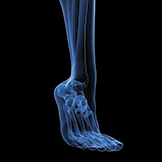
There are many moving parts within the foot and ankle, which means many structures are vulnerable to injury. We have 30 bones and 30 joints between the ankle and the tips of our toes. We also have nine tendons crossing the ankle joint, and dozens of tendons that move our toes. Those numbers alone provide a great opportunity for injury!
Our foot and ankle is a very complex machine, with many important structures that have to be working properly and in coordination with the structures surrounding them. When one of these structures is injured, it needs to be treated properly to restore normal function to this complex machine.
It is estimated that even relatively sedentary people take up to 5,000 steps each day and active people over 10,000 steps. This is why it is paramount to have feet that function well.
We hope you never injure your foot or ankle, but if you do, it is important to see a physician that understands the intricate anatomy and function of all these moving parts.
A physical exam by a knowledgeable doctor is the most important aspect of accurately diagnosing your injury. An injury can’t be accurately treated unless an accurate diagnosis determines what is wrong. Injuries diagnosed and treated early have better outcomes than those treated after they worsen. That being said, a physical exam and X-rays alone will often miss many serious injuries to the foot and ankle.
A trained foot and ankle specialist knows what to look for and will follow up on a high level of suspicion when exams and X-rays do not coincide with what appears to be a more serious injury.
Having that expertise is critical in knowing when to order advanced imaging studies, such as a CT scan or an MRI scan. Ordering these tests when not necessary wastes time and money. However, knowing when to order them will often help diagnose previously missed injuries.
Fortunately, most injuries can be treated nonoperatively, but it is important to get that opinion from an expert. With so many bones and joints in the foot, fractures need to heel in precise alignment.
Displaced fractures left to heal in poor alignment frequently lead to painful function and early post-traumatic arthritis. Tendon ruptures that are not diagnosed and treated early will lead to a weak and often imbalanced foot and ankle.
5,000 steps? 10,000 steps? No matter how many steps you take each day, remember the importance of seeking proper treatment if injury gets in the way.